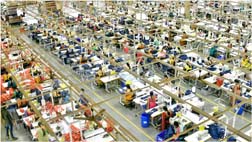C T Online Desk: Shakhawat Hossain Sabbir Special Correspondent Feni : India’s textile exporters are scrambling to find alternative markets in Europe after the United States imposed a steep 50% tariff hike on Indian imports — the highest for any of India’s trade partners.
According to a Reuters report on Tuesday, exporters are offering discounts to existing American buyers while actively exploring new clients across European markets. The move follows U.S. President Donald Trump’s decision in August to double import duties on a wide range of Indian goods, from garments and jewelry to seafood, significantly disrupting India’s export sector.
A Mumbai-based garment exporter, speaking on condition of anonymity, said his company is prioritizing diversification within the European Union (EU). He expressed optimism that India’s exports would rise if an ongoing India–EU free trade agreement (FTA) is finalized soon. Both sides are reportedly working intensively toward signing the deal by the end of this year.
Currently, the EU is India’s largest trading partner, with bilateral trade reaching USD 137.5 billion in the fiscal year ending March 2024 — a nearly 90% increase over the past decade.
Industry insiders say Indian exporters are focusing on meeting the EU’s strict regulations regarding chemical safety, product labeling, and ethical sourcing. Rahul Mehta, chief advisor of the Clothing Manufacturers Association of India, noted that many factories are being modernized to comply with these standards and to reduce dependence on the U.S. market.
During the 2024–25 fiscal year, the U.S. remained India’s top destination for textile and apparel exports, accounting for around 29% of the sector’s USD 38 billion total exports.
Vijay Kumar Agarwal, chairman of the Mumbai-based Creative Group, said some exporters have already begun offering special price cuts to retain U.S. buyers. However, he warned that if the elevated tariffs persist, his company may have to lay off between 6,000 and 7,000 of its 15,000 employees and even consider relocating production to Oman or neighboring Bangladesh within six months.















